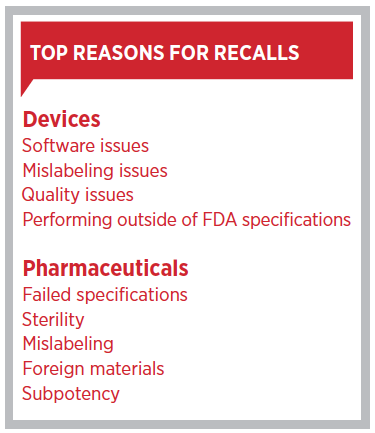How alert systems & hospital processes are helping to better manage device & drug recalls
In recent years, the number of recalls on medical devices and pharmaceuticals has been on the rise, with more than 40 device recalls and more than 80 prescription and over-the-counter drug recalls in 2019 alone. This has increased the pressure on healthcare systems to pull the affected devices and drugs from the supply chain to ensure patient safety. Here’s how some are managing.
Instant alerts

Angie Mitchell, RN, HealthTrust AVP, Clinical Services, remembers how her hospital handled recalls when she first started as a nurse many years ago: “Everything was manual,” she says. This was problematic, because the hospital team didn’t learn about the recall until they heard from the supplier or its sales rep, which could take weeks. During that time, patients continued receiving the recalled item, while those who had already had a device implanted had no idea there could be a problem.
Today, the Food and Drug Administration (FDA) posts recalls on its website as soon as they are approved and sends out daily alerts. HealthTrust also contracts with two suppliers that provide an automated service to help hospitals track and implement recalls, Recall Management (contract #20257) and National Recall Alert Center (contract #20246).

These services monitor FDA notifications 24 hours a day, seven days a week, explains Eric Clapp, HealthTrust Contract Manager for Strategic Sourcing/Purchased Services. The system then sends the recall notification to the healthcare organization. If the email is not opened within 24 to 48 hours, another message is sent, and the process continues until the supplier receives confirmation that the recall notification has been opened. The service also allows hospitals to create an electronic audit log from the time it receives the alert through the removal and customer notification process.
Standardized implementation procedures
While suppliers can help distribute recall information, it is up to the hospital to implement the recall. Speed is crucial when it comes to patient safety.

That’s what impelled St. Luke’s Hospital in Boise, Idaho, to completely revamp its recall program in 2015. “We had a close call with an infant formula recall,” says Crystal Geibel, Business Intelligence Analyst, who manages the hospital’s recall program. The near-miss prompted an internal audit, which revealed an opportunity for centralization and standardization across the system.
Today, the eight-hospital system has a centralized recall program where its facilities receive daily communication about any recalls affecting their areas of treatment. They then have between 24 hours and five days to resolve the issue, depending upon the seriousness of the recall.
Geibel recommends the following to hospitals implementing their own recall programs:
- Set standards for resolution times. The standards should also be integrated into department and system scorecards.
- Ensure senior-level engagement. The effort should be top-down.
- Engage employees. Most are more than willing to participate once they understand that the overall goal of the program is to ensure patient safety.
- Choose the right supplier. Be sure to choose a supplier that serves your facility’s specific needs.
- Report metrics at all levels. That includes system, facility, department and individual metrics. Small facilities shouldn’t be overshadowed by larger units.
- Develop an iterative program. That means setting realistic goals, addressing the barriers at each level and following a systematic approach.
At St. Luke’s, the success of the program is due to both employee buy-in (“This is critical,” Geibel says), and supplier collaboration. “We worked closely with our software provider to make sure they could serve our needs,” Geibel explains. This process increased transparency on the effects of recalls, ease of resolution by end users and better metrics for leadership.
Successful results
St. Luke’s has seen noteworthy results, thanks to its new processes. In the past year, the health system has resolved:
- 100% of Class I recalls (in which the product could cause serious adverse health consequences or death) within 24 hours
- 98% of Class II recalls (in which the product could cause temporary or medically reversible adverse health consequences, or there is little likelihood of serious adverse health consequences) within three days
- 99% of Class III recalls (in which the product is not likely to cause harm) within five days
In 2017, the hospital was a finalist for the ECRI Institute’s Health Device Achievement Award based on its revamped recall system.
Geibel emphasizes that effectively developing a program takes a measured strategy. “Don’t try to tackle everything at once,” she adds.
Share Email Q1 2020, Recalls






